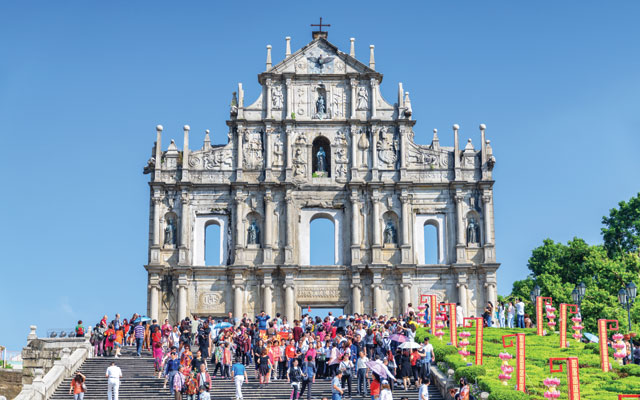Although overcrowding at popular tourist sites is not yet causing major problems for some tourism players, it is not too early to start dispersing traffic to lesser visited areas.
Macau is showing early signs of capacity strains after recent accessibility enhancements in the Pearl River Delta like the high-speed rail connection and the Hong Kong-Zhuhai-Macao Bridge.

During the recent May 1 Labour Day Holiday, visitor arrivals surged 37 per cent to 636,644, almost equivalent to the city’s total population (667,400).
With visitors concentrated in some key attractions, industry players say more can be done to disperse traffic. Based on findings from several visitor profile studies conducted by the Macao Government Tourism Office (MGTO) in the past five years, the top three attractions for the visitors are the Ruins of St Paul’s, Senado Square and Cotai Strip. Taipa and Coloane Village have also experienced visitor surges during peak periods.
China Travel Service (Macao), travel department sales and marketing manager, Pun Cheng-man, said: “We feel the (effects of) overtourism especially during weekends and public holidays. Cotai and Taipa are key sightseeing points, and both are always packed with tourists.”
Pun said the uneven distribution of tourists has caused “nuisances to neighbourhood and local residents”.
Charles Huang, COO of Macau Hotel Sun Sun, located within Inner Harbour, opined: “Overtourism is a result of government’s focus on promoting traditional attractions only.”
Huang suggested that unused piers in Inner Harbour can be transformed into tourist-friendly F&B zones. He also hopes for Inner Harbour to be added as a stop for eventgoers during festivals such as Chinese New Year.
Visitor traffic can also be managed by holding tourist activities outside of peak periods. “For instance, the annual Macao International Fireworks Display Contest takes place on busy weekends. Why not do it Friday? This can also entice visitors to stay one more night. It’d better if the event can be held in first half of the year,” Huang proposed.
In Taipa Village, some tourism players don’t believe crowding is a problem yet. Taipa Village Destination, head of marketing Pamela Chan, said: “Since there is a growing number of attractions in Macau, visitors are being distributed to different areas.”
She added that Taipa Village can afford to continue welcoming more visitors. “I can see the footfall traffic diversification all around Macau, between Cotai, Taipa and the Macau Peninsula.”
A restaurateur who sees tourist business peak in the month of May, too said that visitor traffic is adequately spread out between his Taipa and Macau Peninsula outlets.
“We did see a slight bump in visitors as compared to last year. However, traffic was divided in both areas. Cotai caters to more upmarket tourists and Macau has more options for budget hotels.”
Similar to Chan, he feels he is ready to welcome even more business.
Still, the strong growth in arrivals is already prompting the MGTO and relevant bodies to implement measures to alleviate crowds. For instance, a new app was launched in March 2019 to help residents and visitors better monitor traffic to avoid crowds. The application predicts visitor density at tourist attractions within four hours, 24 hours and seven days, and classifies the forecast at various levels from “comfortable” to “heavily congested”.
The MGTO spokesman said: “Another focus has been on attracting visitors to different parts of the city, during different times of the year, with projects like the Step Out, Experience Macao’s Communities walking tours, along with events like the Art Macao (which inaugurated on June 6), as well as new attractions such as Anim’Arte Nam Van and the Grand Prix Museum.”
Meanwhile, there are pipeline projects for urban planning in and around the Ruins of St Paul’s and Barra. The Transport Bureau has also continually improved traffic control measures, and the Light Rail Transit (Taipa Line) System is expected to be operational in 2019.
Moreover, MGTO hopes to complete feasibility studies within this year, before submitting its findings to the government for further analysis and consideration.




















